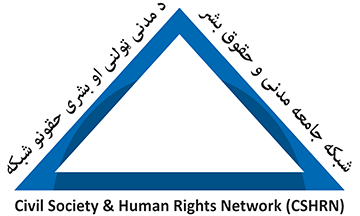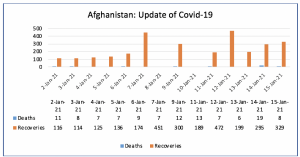Bi-weekly Situation Report
No. 1 (January 01, 2021 – January 15, 2021)

Civil Society and Human Rights Network
Purpose:
This bi-weekly report describes the updates and challenges related to the government’s relief response program, known as Dastarkhan-e-Meli, and health assistance in combating Covid-19 in Afghanistan.
Time Coverage: The report covers all the measures undertaken from January 01 to January 15, 2021, by the government in Afghanistan concerning health and humanitarian assistance during the Covid-19 pandemic.
Geographical Coverage:
Under this report, the updates from the following sixteen provinces are covered: Kabul, Herat, Kandahar, Paktia, Takhar, Laghman, Balkh, Nimroz, Nangarhar, Bamiyan, Jowzjan, Ghor, Kapisa, Helmand, Khost, and Logar.
Situation Overview: The outbreak of Covid-19 has had devastating implications on people’s health and livelihoods across Afghanistan. The economic, social, and health conditions created by the pandemic have further exacerbated the situation to protect vulnerable families, many of whom have already been suffering from low income, social, and health crises due to long-standing conflict over the last several years. According to the World Bank data, Covid-19 pandemic increased the poverty rate from 54.5% to 75% in Afghanistan. Those families, who are dependent on daily wages or remittances from Iran and Pakistan, have especially been affected by the pandemic. To cushion its economic implications, in July 2020, the government of Afghanistan initiated its relief package program (Dastarkhan-e-Meli) to help low-income households across the country who have been heavily affected by the pandemic. Yet, since then, concerns have been mounting over irregularities and misuse of the resources under this program. During the reporting period, CSHRN’s focal points from sixteen mentioned provinces have tracked the aid distribution measures by the local authorities and reported several cases of mismanagement and threats by the Taliban. In addition, during the reporting period, positive tests of Covid-19 have also been on the rise in some provinces, mainly in Kabul. Below is an update of the government’s health and humanitarian assistance provided to families in need.
zCovid-19 Update: On January 4, 2021, the Ministry of Public Health of Afghanistan called on the people to reduce their travels over the next four weeks to contain the possible movement of the mutated version of the virus to Afghanistan. The Covid-19 pandemic has hit hard Afghanistan’s already weak health system. When the pandemic was at its peak, due to poor public health services, most people in Afghanistan preferred home-based treatment to go to doctor or public hospitals. As a result, the exact number of positive tests has not been documented. The actual number of infected people is much higher than the official figure in Afghanistan. Nevertheless, concerns are rising over the second wave of the pandemic, especially in winter in Afghanistan. During the reporting period, official accounts demonstrated several deaths as the result of the pandemic across different provinces. Below is the update during this period.

Source: TOLO News, https://tolonews.com/health
Dastarkhan-e-Meli Update: The relief package Dastarkhan-e-Meli program has been implemented in different districts across the country. It will cover the households in need who will receive food and non-food items such as flour, rice, cooking oil, red beans, chickpeas, and soap. The program will cover more than five million households as a whole both at rural and urban levels in all 34 provinces. The following chart indicates the sixteen targeted provinces in which the program has been implemented.

- Kabul: During the reporting period, people in five districts in Kabul have received the mentioned humanitarian assistance. These districts include Musaei, Khakjabar, Gul-dara, Bagrami, and Chahar Aseyab in which 14678 families across 98 villages in these five districts have received humanitarian assistance. The total cost of this aid is estimated 58,748,000 AFG.
- Logar: While in Logar province, people in two districts such as Khoshi and Pol-alam have received the aid. Yet, there have been reports of misuse in aid distribution by the local authorities in Logar province. For example, according to a report by CSHRN’s focal point in Logar, authorities in Al-tamor village, who were assigned to distribute the aid to more than100 households in this village, have covered only 10 families but kept the remaining 90 aid packages for themselves. In addition, authorities in Logar placed names of individuals in the beneficiary lists who have already left their villages or do not exist there at all. The Taliban’s heavy presence in different districts of Logar also obstructs the aid distribution process. According to findings, a track carrying aid packages to the village was stopped by the Taliban.
- Herat: People received aid packages in six districts in Herat province. The districts include Kashan, Zendajan, Karkh, Oba, Pashtun-zarkhun, and Farsi. The aid has been distributed to 30164 families across 182 councils in this province. The aid cost 122,476,000 AFG of which 1,820,000 AFG was paid for transportation.
- Ghor: The program has been implemented in three districts of Ghor province, including Lal-sarjangal, Shahrak, and Tolak. Around 3180 families across 43 councils have received the aid, which cost 1,702,000 AFG including 430,000 AFG for transportation. However, talking to the local authorities of Citizens’ Charter Afghanistan Project (CCAP), the CSHRN’s focal point in Ghor, said that the program of Dastarkhan-e-Meli has been recently suspended in two districts of Tolak and Shahrak due to growing threats from the Taliban. He also added that the Afghan Aid Organization, which facilitates the program in Ghor, has also stopped the aid distribution because of similar reasons.
- Paktia: In Paktia province, the local authorities have implemented the Dastarkhan-e-Meli program in six districts, including Ahmad-abad, Sayed Karam, Merzaka, Samkani, Shawak, and Waziri. In 77 councils, 4272 deserving families have received the aid packages, which contained 50 kilograms of flour, 6 kilograms of beans, 5 liters of cooking oil, 18 kilograms of rice, 6 pieces of soap, and 4000 AFG cash for each family. The packages cost 17,088,000 AFG in total.
- Nangarhar: Six districts have been covered by the program in Nangarhar province, which include Surkh-road, Koz-konar, Dare-nor, Achin, Ghani-khel, Chaparhar, Kama, and Kheva. As a result, 33,278 families in need across 181 villages have received the aid packages. The total amount of aid packages is 133,112,000 AFG.
- Jawzjan: Dastarkhan-e-Meli program reached out to the deserving families only in two districts in Jawzjan province such as Sheberghan and Faizabad. In Sheberghan district, 134 councils and in Faizabad 68 councils have received aid packages that have been distributed to 44916 families in need.
- Khost: Four districts of Khost province have been covered by Dastarkhan-e-Meli These districts are Nadershahkot, Ismail Khil, Mutun, and Gurbuz. The local authorities have distributed aid packages to 7835 families across 372 communities. The total amount of aid packages has cost 15240000 AFG.
- Nimroz: In Nimroz province, the relief package of Dastarkhan-e-Meli program has been implemented in three districts such as Kang, Chakhansor, and Chahar-borjak. According to the report, 3285 families across 87 councils have received aid support. The total cost of aid packages has been estimated 14,010,000 AFG.
- Balkh: An estimated number of 20000 poor families across four districts of Mazar-e-Sharif such as Khelm, Marmal, Chahar-kent, and Balkh have received 4000 AFG aid packages. The total amount of this aid is estimated 80,000,000 AFG. The aid distribution process in these districts has not yet been completed.
- Helmand: A total number of 6540 families in two districts of Helmand such as Nawa and Lashkargah across 53 councils have received aid packages. The total amount of this aid cost 26,170,000 AFG.
- Takhar: People in four districts of Takhar province such as Warsaj, Chah-ab, Samuj, and Namag-ab have received aid packages. However, with the exception of Warsaj, the aid distribution has been halted in three other districts as the result of threats by the Taliban.
- Kapisa: Families only in Najrab district of Kapisa province have received aid packages. Around 909 families have been covered across 14 villages in Najrab district. The total amount of aid distributed was 3,636,000 AFG.
- Bmaiyan: Around 3912 families across 48 villages in two districts of Bamiyan such as Waras and Panjab, have received aid packages. The aid packages have amounted to 15,648,000 AFG.
- Laghman: Around 6789 families across 54 villages in two districts of Laghman province such as Mehtarlam and Qarghaee have received aid packages. The total amount of aid was 27,156,000 AFG.
Kandahar: Around 4093 families across 66 villages in three districts of Kandahar province have received aid packages. The total amount of this aid was 16,372,000 AFG.